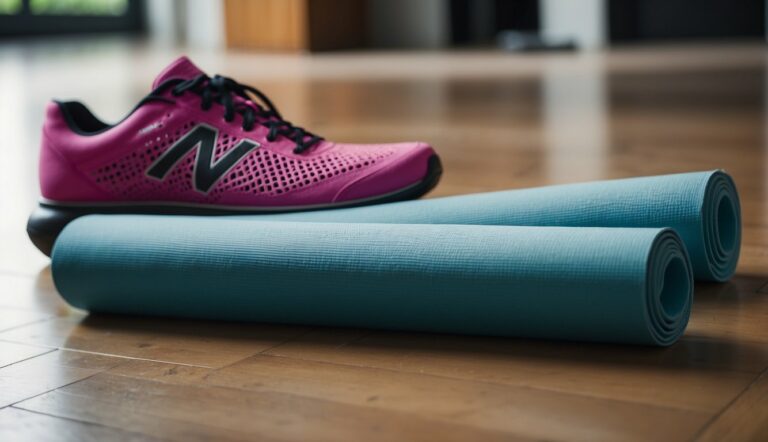5 Treadmill Workouts That Are Perfect for WINTER Training
Winter brings a unique set of challenges for runners, from icy paths to biting winds and shorter daylight hours. These conditions make outdoor running not just unpleasant but sometimes unsafe. That’s where the trusty treadmill comes in – a perfect tool for maintaining your running regimen in the warmth and safety of the indoors.
Treadmills offer a controlled environment where you can simulate various types of outdoor runs, adjust the difficulty level, and track your progress with precision. They’re not just a fallback option but a powerful training ally that can help you stay on top of your fitness goals, even when the weather outside is frightful.
In this post, we’ll explore five treadmill workouts that are ideal for winter training, providing you with a mix of endurance, strength, and speed sessions to keep your workouts diverse and engaging.
1. The Progressive Run
The Progressive Run is a workout that mimics the natural variation of outdoor running and can help improve your endurance. It’s a simple concept: start at a pace that feels easy and gradually increase your speed, making the workout progressively harder.
This type of run can help you learn how to pace yourself and manage your energy reserves over the course of a run.
Workout Structure:
- Warm-up: Begin with a 10-minute jog at a comfortable pace to get your muscles warm and ready for the workout. The warm-up is crucial for preventing injuries and preparing your body for the increased effort to come.
- Main Set: After warming up, it’s time to start the progressive aspect of the workout. Increase your treadmill’s speed by a small and manageable amount every 5 minutes. For example, if you start running at 6 mph, you can increase to 6.2 mph at the 5-minute mark, 6.4 mph at the 10-minute mark, and so on. Continue this pattern for 30 minutes. The key is to make the increments small enough that you can sustain the final pace for the last 5 minutes without feeling completely exhausted.
- Cool-down: Slow down to your initial warm-up pace for a 5-minute cool-down. This helps your heart rate return to normal and starts the recovery process.
Practical Tips:
- Monitor Your Effort: Use a heart rate monitor or the perceived effort scale to ensure you’re not pushing too hard too soon. You should be able to complete the workout without feeling completely drained.
- Stay Hydrated: Even though you’re indoors, you’re still sweating and losing fluids, so keep a water bottle handy.
- Focus on Form: As you get tired, it’s common for your form to suffer. Pay attention to your running posture, keeping your shoulders relaxed, your arms swinging naturally, and your gaze forward.
Remember, the Progressive Run is about control and gradual improvement. It’s not a race to the highest speed but a methodical increase that challenges your endurance and teaches you about pacing.

2. Hill Intervals
Hill intervals are an excellent way to build leg strength, boost cardiovascular fitness, and break the monotony of flat treadmill runs. They replicate the challenge of running up inclines, which can be hard to come by during the icy winter months.
This workout will help you develop power and endurance, and the changing incline will keep your mind engaged.
Workout Structure:
- Warm-up: Start with a 10-minute jog at a 0% incline. This should be at an easy, conversational pace to prepare your body for the more intense workout ahead.
- Main Set: After your warm-up, increase the incline to 4% and maintain your pace for 1 minute. Then, reduce the incline back to 0% and jog for 2 minutes to recover. Next, raise the incline to 5% for another minute, followed by a 2-minute recovery at 0%. Continue this pattern, increasing the incline by 1% each time, up to 6% or 7%, depending on your fitness level and experience with hill running. After reaching your peak incline, work your way back down in the same manner.
- Cool-down: Finish with a 5-minute jog at a 0% incline to help your muscles recover and your heart rate return to normal.

Practical Tips:
- Adjust Your Stride: When running on an incline, you might need to shorten your stride and increase your cadence to maintain efficiency.
- Lean In: Lean slightly forward from your ankles as you run uphill, similar to how you would naturally lean into a real hill. Avoid leaning from your waist, which can strain your back.
- Breathing: Pay attention to your breathing. Inclines make your cardiovascular system work harder, so focus on maintaining a steady, rhythmic breathing pattern.
- Don’t Skip the Recovery: The recovery intervals are just as important as the incline intervals. They allow your heart rate to come down and your muscles to recover slightly, making the workout sustainable.
3. Speed Play (Fartlek)
Fartlek, which means “speed play” in Swedish, is a form of interval training that is less structured than traditional interval workouts.
It’s a fun and creative way to introduce spontaneity into your runs, as it alternates between faster and slower running without specific time or distance requirements.
Workout Structure:
- Warm-up: Begin with a 10-minute easy-paced jog to warm up your muscles and prepare your body for the variable speeds ahead.
- Main Set: After warming up, spontaneously increase the treadmill’s speed to a challenging but sustainable pace for anywhere from 30 seconds to 2 minutes, then slow down to a comfortable jog or brisk walk for a similar duration as your recovery. The idea is to mix up the speeds and recovery times based on how you feel, rather than sticking to a rigid pattern. This could mean doing a fast segment when a motivating song comes on your playlist or slowing down when you need a breather. Continue this pattern of alternating speeds for 20-30 minutes.
- Cool-down: Conclude with a 10-minute jog at an easy pace to cool down your body and help prevent stiffness and soreness.

Practical Tips:
- Listen to Your Body: Fartlek is less about hitting exact paces and more about tuning into how you feel. Push yourself during the fast intervals, but not so hard that you can’t recover during the slower periods.
- Use Music or Podcasts: To make the workout more engaging, use your favorite upbeat music for faster intervals and slower tunes or a podcast for recovery periods.
- Stay Flexible: The beauty of Fartlek is its flexibility. Don’t be afraid to change your plan on the fly. If you’re feeling good, you might run a longer fast interval, or if you’re tired, you might extend your recovery.
4. Tempo Run
A tempo run, or threshold run, is designed to be run at a pace that is comfortably hard; it’s the “goldilocks” pace that is just right for improving your running economy and increasing your lactate threshold.
This type of workout is especially beneficial for distance runners looking to improve their race times.
Workout Structure:
- Warm-up: Start with a 10-minute jog at an easy pace. This warm-up period should gradually increase your heart rate and prepare your body for the sustained effort to come.
- Main Set: After the warm-up, transition into your tempo pace. This should be a pace you can maintain for a prolonged period—typically about 20 minutes—but that feels challenging. It’s often described as a pace where you can only utter a few words at a time. Maintain this tempo pace for the duration of the main set, focusing on keeping a consistent speed.
- Cool-down: Finish with a 10-minute jog at a slow, comfortable pace to help your body recover and reduce the risk of post-workout soreness.
Practical Tips:
- Find Your Tempo Pace: If you’re unsure of your tempo pace, a general guideline is to run at a pace that is about 25 to 30 seconds slower per mile than your current 5K race pace.
- Stay Relaxed: Even though you’re running at a challenging pace, try to keep your upper body relaxed. Tension in your shoulders or arms can waste valuable energy.
- Control Your Breathing: Establish a breathing rhythm that matches your stride. This can help you maintain a steady effort throughout the workout.

5. Ladder Workout
Ladder workouts are structured with intervals of increasing and then decreasing lengths, allowing you to push your speed and endurance in a single session.
They provide a great mix of intensity and can be customized to suit any fitness level.
Workout Structure:
- Warm-up: As with all good workouts, begin with a 10-minute easy-paced jog to warm up your muscles.
- Main Set: Start with a 1-minute interval at a challenging but manageable pace, followed by a 1-minute easy recovery jog. Next, move up the “ladder” by increasing the fast interval to 2 minutes, with a 2-minute recovery, and so on, until you reach a peak interval length that suits your fitness level—this could be anywhere from 3 to 5 minutes. After hitting the peak, work your way back down the ladder, decreasing the interval lengths until you finish with the 1-minute interval you started with.
- Cool-down: Conclude with a 10-minute jog at an easy pace to help your body cool down and initiate the recovery process.
Practical Tips:
- Adjust the Speed: The speed of your intervals should be challenging but not an all-out sprint. Aim for a pace that feels like a 7 or 8 out of 10 in terms of effort.
- Focus on Recovery: Use the recovery periods to prepare for the next interval. Take deep breaths, slow your pace, and get ready to ramp up the intensity again.
- Stay Engaged: Ladder workouts can be mentally challenging because of their varying lengths. Keep your mind engaged by focusing on each interval as a mini-goal to conquer.
Conclusion
Incorporating these five treadmill workouts into your winter training can help you not only maintain but also improve your running performance during the colder months. Each workout serves a specific purpose, whether it’s building endurance, strength, or speed, and they all offer the variety needed to keep your indoor running routine fresh and motivating.
Consistency is key to reaping the benefits of any training plan, and with these treadmill workouts, you can stay consistent with your running regardless of the weather outside. They’re designed to mimic the challenges of outdoor running and can be adjusted to fit any fitness level.
Lastly, remember to keep things interesting. Treadmill running doesn’t have to be a monotonous slog. Use these workouts as a framework, but feel free to add your own tweaks to suit your preferences and goals. Mix up your playlist, try different incline and speed combinations, and set yourself new challenges to keep your winter treadmill sessions engaging and effective.
With the right approach, the treadmill can be a powerful ally in your winter training arsenal, helping you to emerge into spring as a stronger, faster, and more resilient runner.






